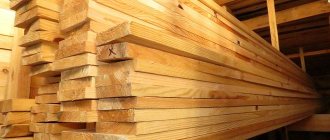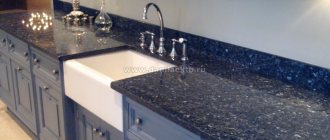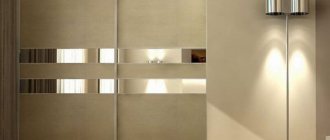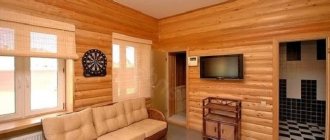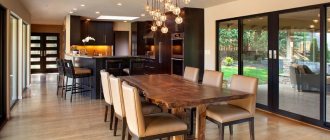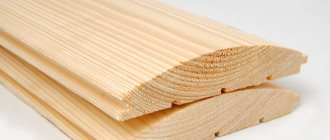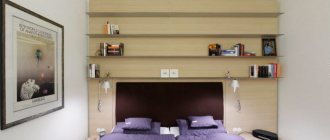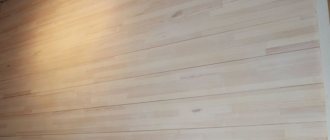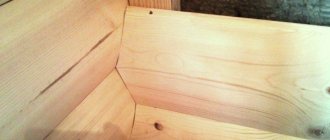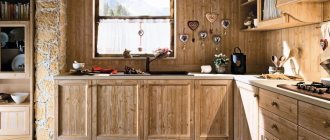To decorate the walls of a building, materials are increasingly being used that do not require special installation skills, while at the same time decorating the surface in an original way and reliably protecting it from external influences.
A popular trend is the technology of suspended structures, a feature of which is the presence of a ventilated gap between the wall and the covering. The ventilation façade elements are fastened to the sheathing.
House panels, which have the appearance of lining, are widely used both for interior decoration and for the exterior design of external walls.
A block house can be made of natural wood, or it can be vinyl or metal; the sizes of each type of house panels are different.
Features of the block house profile
Many consider the block house to be a special type of lining with a rounded front part. In fact, the scope of application and manufacturing technology of this material are similar to lining, but the block house is a facing profiled board that imitates a rounded log.
This material came to Russia from the West. Translated from English, “blockhouse” means block house. A block house is what we call a frame house. Covering the walls with block house boards allows you to create an imitation of a wooden house built from rounded logs.
Each board has a special profile. On its back side, longitudinal grooves are made by milling. Their purpose is to remove moisture and ventilate the skin, relieving stresses arising due to sudden changes in temperature and humidity. Many modern profiled wood materials have such structural elements.
The back side of the block house.
An important detail of a house block is a high-quality lock, which is a connecting tongue and groove.
This connection of panels provides:
- no gaps between cladding elements;
- the ability to hide fastening parts - clamps, nails or screws are hidden by the next board;
- reduction of finishing time.
Tecos
Canadian manufacturer Tecos produces high-quality vinyl flooring imitation block houses. Thanks to the quality characteristics of the products, the company has its consumers in Russia.
Tekos panels have distinctive features:
- the material is resistant to low temperatures;
- the panels are durable and resistant to weather conditions;
- has increased moisture resistance.
The coating has good thermal insulation properties, as well as a variety of colors.
According to the technical characteristics of Tecos vinyl panels, they are determined by the following indicators:
- length - 3780 mm;
- width - 264 mm;
- sheet thickness - 1.2 mm;
- plate weight - 2.03 kg;
- flammability - G2 class.
The panels are laid by the manufacturer in 18 pieces per package.
Wood species used for the production of block houses
Almost any wood is suitable for manufacturing. The most popular types of wood are spruce or pine. It is possible to use hardwoods as raw materials: oak, linden, aspen, alder.
Block house made of pine.
Angara pine has impeccable performance characteristics. This material belongs to the luxury class. It has no falling knots, is well processed, and has an attractive shade. As a rule, such boards are used for finishing solid and expensive houses.
A block house made of larch is well appreciated. The boards have a characteristic whitish tint and are not susceptible to destruction by pathogenic flora. In addition to cladding houses, larch material is often used for cladding baths. Its wood does not release resin at high temperatures, which eliminates skin burns and damage to the appearance of the wall.
Block house made of larch.
Due to the higher price, profiled oak boards are used less frequently. Although oak wood is aesthetically pleasing and durable, its grain pattern becomes dull over time. To maintain the attractive appearance of such cladding, it is necessary to properly care for it.
Due to the low strength characteristics and reduced durability of the cladding, dead wood or firewood is not used for the manufacture of panels. The forest selected for processing must be healthy and alive.
Block house production technology
The blank for making the material is a board obtained after sawing logs. The production process is divided into 4 stages.
Log sawing
Logs of suitable size are pre-selected. First, they are sawn into boards using the “square in a circle” technology. It received this name due to the fact that the result of sawing is a square beam and side external elements. It is the latter that go into making a block house. Next, the blanks are transferred to other machines and modified in width.
Scheme of sawing a log.
Drying workpieces
The resulting boards are placed in chamber drying units. This allows the wood moisture content to be reduced to the norm of 12%. When this parameter is reached, the material becomes resistant to the negative effects of the environment - precipitation in the form of rain and snow. In addition, drying prevents the formation of blue stains in the wood.
Loading boards into the dryer.
Trimming and planing boards
The most important stage, during which the modified workpieces are processed using high-tech modern equipment. Fastening elements - tenons and grooves - are cut with high precision, and air channels are made. Since at this stage the board already has a perfectly polished surface, no additional processing is required.
Machine for making block house profiles.
Sorting and packaging
The resulting block house is sorted by quality class - appearance. After this, the material is securely packaged in film.
Packed block house.
Familiar dimensions
Each panel is a segment of a log, so after finishing activities the structure resembles a familiar log house. Coniferous wood species such as pine and spruce are usually used for production. However, production is not limited only to these raw materials.
Before you do the finishing with your own hands, you need to decide on the dimensions of the material. The special table below will help you familiarize yourself with the basic indicators.
| Main parameter | Value in millimeters |
| Length | 2000-6000 |
| Width | 90-190 |
| Thickness | 20-45 |
The most common dimensions.
Note! The width of the blockhouse and other parameters may exceed the specified values, since the table shows only the most common product sizes.
Block house varieties and what documents they are regulated by
In our country there are no GOST standards regulating the production of block houses. For this reason, manufacturers focus on those standards that are suitable for specific production conditions. Due to the lack of standards, you can find a wide variety of block house and its varieties on the market.
Most often, domestic manufacturers use the Soviet GOST 8242-88 “Profile parts made of wood and wood materials for construction,” which is used for the production of lining.
In particular, they are guided by its rules regarding:
- permissible geometric deviations when cutting elements;
- processing parameters and surface roughness;
- acceptable product defects;
- humidity criteria (12% - inside, 15% - outside);
- rules for transportation and packaging of products;
- ways to check quality characteristics.
Foreign regulations are more stringent. Many people use the German version of material standardization in accordance with the standards “Solid softwood paneling and cladding - Machined profiles with tongue and groove; German version EN 14519:2005".
This pan-European standard has the name: “Panels and cladding made of solid coniferous wood - with profiled groove and tongue.” This regulation has standards similar to the domestic GOST and provides for the division of block houses into quality classes “A” and “B”.
As for Russia, there is no precise classification of block houses by grade. The names of the categories can be whatever you want (as is more convenient, “Classic”, “grade A or B” or intermediate types - “AB”, there may even be a 3rd grade - C.
Let us give an approximate classification by categories and varieties, which is used most often.
“Extra” grade – the highest
It does not allow the presence of cracks, knots and other small flaws in the material. There are no traces of mechanical processing - the profiled board has an ideal surface on the front side.
Grade "A"
Any mechanical damage to the material is not allowed. On 1 meter of the board there should not be: resin pockets longer than 30 mm, 2 or more knots with a diameter greater than 30 mm.
Grade "B"
Per meter of length, a board may have no more than one mechanical damage on the inside resulting from processing. The presence of knots per 1 meter is no more than 4, diameter up to 30 mm. The surface with knots should be light, the texture of the wood should be vibrant.
Grade "C"
It is possible to have any number of dark and light knots, the diameter of which does not exceed 30 mm.
Products of higher grades have a slightly higher price. They are used to decorate the interior walls of a house or apartment.
Panel categories – from A to C
If we are talking about average values, then the length is 2-6 meters, the width is 9-18 cm, the thickness range is 20-40 mm. Block House differs not only in size, but also in quality, and this information is marked on the packaging.
Category A
The classes are marked with the letters A, B, C. Category A are products on which the presence of one “live” knot on every one and a half meters of the panel is acceptable, resin pockets - a maximum of two pieces, non-through cracks - also two.
Category B
For a Block House of category B, no more than four knots are allowed for the same length (1.5 m) (and their diameter should be a maximum of 2 cm); the number of permissible blind cracks and resin pockets is two.
Category C
On panels of category C there may be cracks with a length of no more than 5% of the length of the entire product. The diameter of the resin pockets should be no more than 6 mm, and the length of the knots should not exceed 2.5 cm.
It should be borne in mind that manufacturers classify panels with different parameters into certain classes, i.e. their standards may differ. However, in any situation, the highest quality panels are category A.
In a number of cases, there are products marked with class AB - here we are talking about the presence of flaws belonging to both categories.
Block house dimensions
The thickness of the material is measured from the highest point of the front surface perpendicular to the back side. As a rule, a board is made with an optimal cross-sectional proportion - the thickness corresponds to the width of the material. This is how its strength characteristics are maintained, since boards of greater width and insufficient thickness are susceptible to cracking and warping.
When ordering material, it is important to consider that the working and overall width of the block house are divided. After installation, part of the board is hidden - the tenon entering the groove of the adjacent panel is covered by it.
Working width is the part that is visually visible after assembling the shield.
Working size.
Dimensions of a block house for exterior finishing
The requirement for external cladding is resistance to the external environment. Coniferous wood material is used for exterior finishing. The facade is sheathed with boards with a more convex profile.
Block house for exterior finishing.
Most often, panels from 3 to 6 meters long are used for exterior wall cladding, having the following dimensions:
- 140 x 30 mm;
- 142 x 36 mm;
- 190 x 36 mm.
According to standard sizes, boards for external finishing are conventionally divided into:
- universal – 3 or 6 meters long with dimensions 42 x 36 mm;
- wide universal - 2, 3 or 6 meters long with dimensions 142 x 28 mm;
- wide facades - 4 or 6 meters long with dimensions 193 x 36 mm.
The house is finished with a block house.
Installation without insulation
We recommend using it for finishing the external walls of well-insulated buildings. This technology reduces the total estimated cost of construction work and shortens its time. There are no fundamental differences in technology. If, during work with insulation, the installation was carried out precisely for the main lathing, and the counter-lattice was done automatically, then here you need to correctly fix the slats for the block house.
Wall before finishing
Fixed sheathing and installation of block house
Exterior of the house after finishing
The most difficult finishing areas are door and window openings. Work very carefully. Take all measures to prevent water from getting between the wall and the sheathing.
House lined with block house
